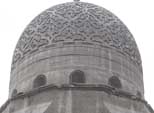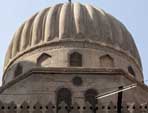Masons at Work
Bernard O'Kane
American University in Cairo

Bernard O'Kane
American University in Cairo
The Carved Stone Domes of Cairo
The patterns carved on Cairo's stone domes are unique for their number and variety. Serious study of these began with Kessler's monograph of 1976, which photographed all of the examples and analysed the relationships of pattern to stone courses, establishing for the first time a connection between the two. Almost no further work on the topic was done until a workshop was convened at MIT in 2005, spurred by the conservation work and detailed drawings of the Aga Khan restoration projects in the Darb al-Ahmar area. The presented findings related in particular to the statics of the domes and showed how the latest in the series had, unexpectedly, reinforcements of iron clamps.
However, some basic construction questions about this series remains, including whether the patterns were carved in situ or first on the ground, and the methods of centering used. But other questions have barely been investigated, such as the ways in which the patterns might have been generated to fit the forms of the domes. Previous publications have suggested that "in the layout of the decoration, the number four, following the shape of a square, and its multiples (8, 16, 32, 64) are the basis of the design." In fact a more careful analysis of dome designs reveals a much greater variety, with examples of five, ten, twelve, twenty, twenty-eight, and forty-sided patterns also known. The only drawing of the pattern of the finest dome of all in the series, that of Qaytbay in the Northern cemetery, for instance, shows it as having a sixteen-sided pattern instead of the ten-sided one it actually has.
Other irregularities that need be explored and explained include the orientations of the designs, not always on the main axes of the building, and frequently not integrated with the numbering and orientation of the windows and blind niches that normally articulate the drums of these domes.
The paper explores the varieties of designs on the domes and their relationship to the other architectural elements, and will examine the implications that these have for the design and construction techniques of this unparalleled ensemble.
However, some basic construction questions about this series remains, including whether the patterns were carved in situ or first on the ground, and the methods of centering used. But other questions have barely been investigated, such as the ways in which the patterns might have been generated to fit the forms of the domes. Previous publications have suggested that "in the layout of the decoration, the number four, following the shape of a square, and its multiples (8, 16, 32, 64) are the basis of the design." In fact a more careful analysis of dome designs reveals a much greater variety, with examples of five, ten, twelve, twenty, twenty-eight, and forty-sided patterns also known. The only drawing of the pattern of the finest dome of all in the series, that of Qaytbay in the Northern cemetery, for instance, shows it as having a sixteen-sided pattern instead of the ten-sided one it actually has.
Other irregularities that need be explored and explained include the orientations of the designs, not always on the main axes of the building, and frequently not integrated with the numbering and orientation of the windows and blind niches that normally articulate the drums of these domes.
The paper explores the varieties of designs on the domes and their relationship to the other architectural elements, and will examine the implications that these have for the design and construction techniques of this unparalleled ensemble.


